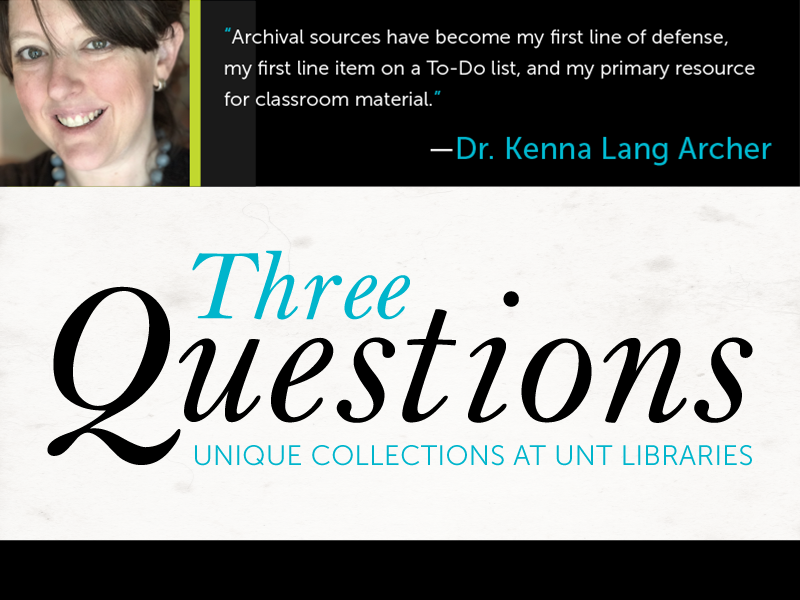Three Questions with Kenna Lang Archer

Three Questions is an initiative to share the value that our faculty, students, and others in the UNT community derive from using The Portal to Texas History at UNT Libraries.
-
How important are Unique Collections in your teaching, learning or research?
It is no exaggeration to say that the Unique Collections are necessary for me to do my work. In the classroom, I incorporate primary sources into every lecture, and my personal research unequivocally depends on my ability to access primary sources that are diverse in their geography, chronology, and type. Unfortunately, it is increasingly difficult (at times, mind-numbingly so) to track down primary sources that are both authentic and available. That is why the Portal to Texas History and the Special Collections are so very important!
-
How have Unique Collections changed the way you approach your research, teaching or learning?
Primary sources allow us (as teachers, as researchers, or as students) to see history unfold not as a string of facts but as a story of diverse experiences and deep-rooted assumptions, individual struggles and shared challenges, scientific hubris and technological triumph. This is because, by their very nature, primary sources are close to the subject at hand. As I have become more aware of the impact that these sources can have in my work, I have become more dependent on Unique Collections. When I am prepping my classes, I now spend as much time parsing the sources in the Portal to Texas History as I do writing notes, prepping powerpoints, or reading textbooks. Archival sources have become my first line of defense, my first line item on a To-Do list, and my primary resource for classroom material.
-
What do you want others to know about your research, teaching or learning?
One of the courses that I teach regularly is Texas History. Frequently, I will have students who think they have heard it all (having grown up in the state), but I also get students who know absolutely nothing about the state. It can be challenging, from a teacher’s perspective, to engage students along this spectrum. For example, how do you teach the (very much loaded) story of The Alamo for both the first time and the millionth time? What I have discovered is that the sources in the Unique Collections are precisely what I need. Sources from the Portal to Texas History, for example, help to make this history more accessible, more relevant, and more intellectually uncomfortable/challenging. My students learn more and grow more when I present them with sources from the Unique Collections (they also enjoy the class quite a bit more), and frankly, I am a much better teacher when I am engaging these sources as well.
Dr. Kenna Lang Archer is a Senior Instructor at Angelo State University in San Angelo, Texas, where she teaches U.S. environmental history, Texas history, and American history. Her first book, Unruly Waters, was published by University of New Mexico Press. She recently finished writing an updated edition of Ogallala: Water for a Dry Land with John Opie and Char Miller. She will be presenting her current research project at the Western History Association meeting in October.

